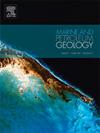A sequence boundary related aeolian sand record in a continental basin: The Cretaceous-Paleogene White Sandstone Member, Tabei Uplift, Tarim Basin, NW China
IF 3.6
2区 地球科学
Q1 GEOSCIENCES, MULTIDISCIPLINARY
引用次数: 0
Abstract
A sequence boundary typically corresponds to an unconformity, with fluvial incised-valley fills representing a classic depositional model. However, aeolian deposits associated with sequence boundaries, though equally significant, have received less attention in studies of continental basins. Therefore, this study investigates aeolian sand sedimentary records near a sequence boundary in a continental basin based on an integrated analysis of 3D seismic volumes, wireline logs and cores from the Cretaceous-Paleogene deposits in the Tabei Uplift (Tarim Basin, NW China). The Cretaceous-Paleogene White Sandstone Member was formed in a salt-lake margin desert environment above a local unconformity surface that is well recognized on seismic profiles. The studied sandstone sequence is characterized by its friable texture and exhibits distinctive aeolian depositional features, including developed grainfall strata and grainflow strata within the core samples. Scanning electron microscopy (SEM) analysis reveals the presence of abundant dish-shaped impact pits on quartz grain surfaces, providing compelling evidence for the aeolian origin of these sandstones. During the Late Cretaceous to Paleogene period, the study area underwent significant geomorphological changes due to the tectonic uplift of the Tianshan and Kunlun Orogenic Belts. This tectonic activity resulted in the progressive erosion of Cretaceous strata in both the northwestern and southeastern regions of the research area. During this period, with regression of the Tarim Sea, aridity gradually increased, leading to the formation of extensive aeolian sands in the area. The aeolian sandstone pinches out from the southeast to the northwest in the area east of the WM7 fault belt. In the Paleogene, incised valleys were developed and transported eroded aeolian sands to the salt lake in the northwest. This study demonstrates the transformation of Cretaceous-Paleogene aeolian sand in a "sandstone factory" in the northern Tarim Basin during a greenhouse period. The "sandstone factory" provides an opportunity for research on sequence boundary-related aeolian sandstone unrelated to a fluvial incised valley in a continental basin.
陆相盆地层序边界相关风成砂记录:塔里木盆地塔北隆起白垩系—古近系白砂岩段
层序边界通常与不整合相对应,河流切谷充填代表了典型的沉积模式。然而,与层序边界有关的风成沉积虽然同样重要,但在大陆盆地的研究中受到的关注较少。因此,本研究在综合分析塔北隆起白垩系—古近系沉积三维地震资料、电缆测井资料和岩心资料的基础上,对陆相盆地层序边界附近的风成砂沉积记录进行了研究。白垩系—古近系白砂岩段形成于盐湖边缘的沙漠环境中,在地震剖面上可以很好地识别局部不整合面。研究的砂岩层序结构脆弱,具有明显的风成沉积特征,岩心样品内发育粒落层和粒流层。扫描电镜(SEM)分析显示,石英颗粒表面存在丰富的盘状撞击坑,为这些砂岩的风成成因提供了有力的证据。晚白垩世至古近纪,由于天山造山带和昆仑造山带的构造隆升,研究区发生了明显的地貌变化。这种构造活动导致研究区西北部和东南部白垩系地层的递进侵蚀。这一时期,随着塔里木海的退缩,干旱逐渐加剧,形成了大面积的风沙。在WM7断裂带以东,风成砂岩由东南向西北挤压。古近纪发育切谷,将侵蚀的风成沙输送到西北盐湖。研究了塔里木盆地北部“砂岩工厂”白垩系-古近系风成砂在温室期的转化过程。“砂岩工厂”为研究与陆相盆地河流切割谷无关的层序边界风成砂岩提供了机会。
本文章由计算机程序翻译,如有差异,请以英文原文为准。
求助全文
约1分钟内获得全文
求助全文
来源期刊

Marine and Petroleum Geology
地学-地球科学综合
CiteScore
8.80
自引率
14.30%
发文量
475
审稿时长
63 days
期刊介绍:
Marine and Petroleum Geology is the pre-eminent international forum for the exchange of multidisciplinary concepts, interpretations and techniques for all concerned with marine and petroleum geology in industry, government and academia. Rapid bimonthly publication allows early communications of papers or short communications to the geoscience community.
Marine and Petroleum Geology is essential reading for geologists, geophysicists and explorationists in industry, government and academia working in the following areas: marine geology; basin analysis and evaluation; organic geochemistry; reserve/resource estimation; seismic stratigraphy; thermal models of basic evolution; sedimentary geology; continental margins; geophysical interpretation; structural geology/tectonics; formation evaluation techniques; well logging.
 求助内容:
求助内容: 应助结果提醒方式:
应助结果提醒方式:


